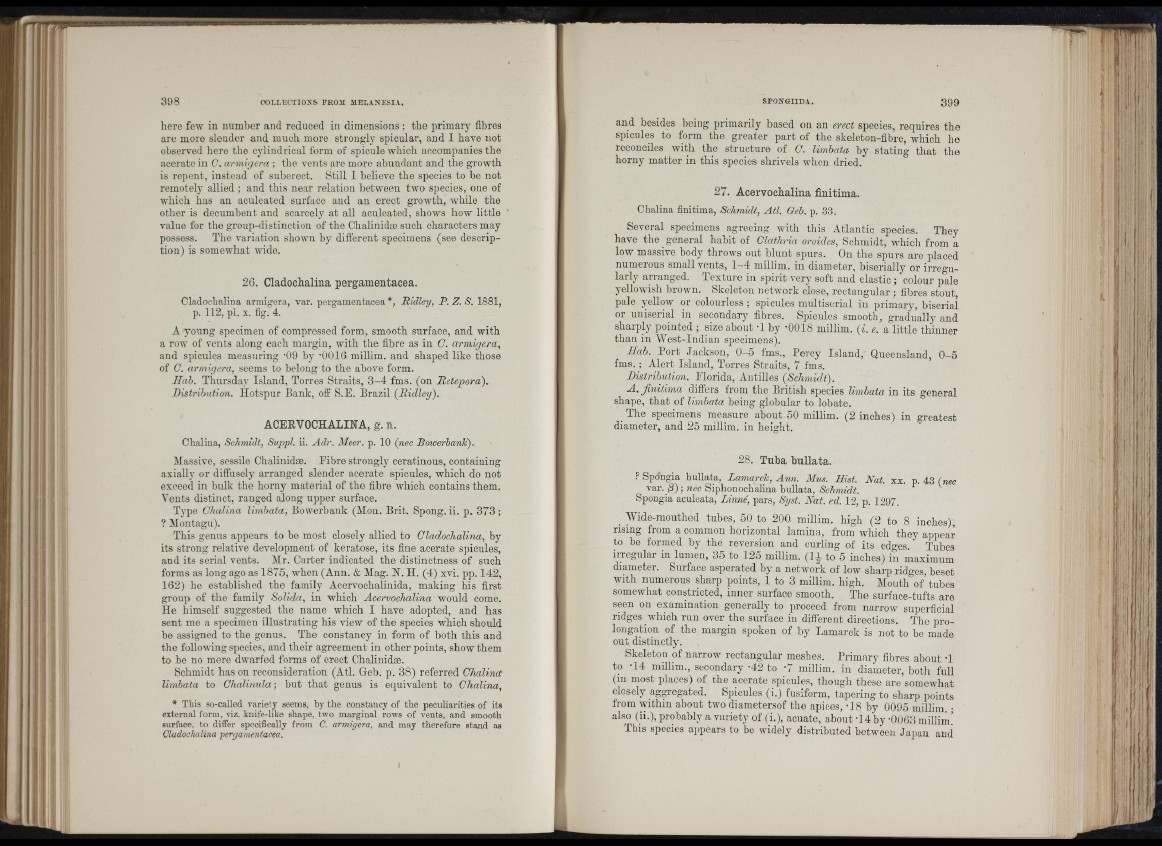
here few in number and reduced in dimensions ; the primary fibres
are more slender and much more strongly spicular, and I have uot
observed here the cylindrical form of spicule which accompanies the
acerate iu G. armigera ; the vents are more abundant and the growth
is repent, instead of suhercot. Still I believe the species to be not
remotely allied ; and this near relation between two species, one of
which has an aculeated surface a:id an erect growth, while the
other is decumbent and scarcely at all aculeated, shows how little
value for the group-distinction of the Chalinidæ such characters may
possess. The variation shown by different specimens (see description)
is somewhat wide.
26. Cladochalina pergamentacea.
Cladochalina armigera, var. pergamentacea ’
p. 112, pi. X. fig. 4.
Ridley, P. Z. S. 1881,
A young specimen of compressed form, smooth surface, and with
a row of vents along each margin, with the fibre as in C. armigera,
and spicules measuring ‘09 by '0016 millim. and shaped like those
of C. armigera, seems to belong to the above form.
Hah. Thursday Island, Torres Straits, 3 -4 fms. (on Reteporai).
Distribution. Hotspur Bank, off S.E. Brazil (Ridley).
ACEKVOCHALINA, g. n.
Chalina, Schmidt, Suppl. ii. Adr. Aleer. p. 10 (nec Bowerbank).
Massive, sessile Chalinidæ. Libre strongly ceratinous, containing
axially or diffusely arranged slender acerate spicules, which do not
exceed in hulk the horny material of the fibre which contains them.
Yents distinct, ranged along upper surface.
Type Chalina limbata, Bowerbank (Mon. Brit. Spong. ii. p. 373 ;
? Montagu).
This genus appears to be most closely allied to Cladochalina, by
its strong relative development of keratose, its fine acerate spicules,
and its serial vents. Mr. Carter indicated the distinctness of such
forms as long ago as 1875, when (Ann. & Mag. N. H. (4) xvi. pp. 142,
162) ho established the family Acervochalinida, making his first
group of the family Solida, in which Acervochalina would come.
He himself suggested the name which I have adopted, and has
sent me a specimen illustrating his view of the species which should
be assigned to the genus. The constancy in form of both this and
the following species, and their agreement in other points, show them
to be no mere dwarfed forms of erect Chalinidæ.
Schmidt has on reconsideration (Atl. Geb. p. 38) referred Chalina
limbata to Chalinula; but th at genus is equivalent to Chalina,
* This so-called variety seems, by the constancy of the peculiarities of its
external form, viz. knife-like shape, two marginal rows of vents, and smooth
surface, to differ specifically from C. armigera, and may therefore stand as
Cladochalina •pergamentacea.
and besides being primarily based on an erect species, requires the
spicules to form the greater part of the skeleton-fibre, which he
reconciles with the structure of C. limbata by stating th at the
horny matter in this species shrivels when dried.
27. Acervochalina finitima.
Chalina finitima, Schmidt, Atl. Geb. p. 33.
Several specimens agreeing with this Atlantic species. They
have the general habit of Clathria oroides, Schmidt, which from a
low massive body throws out blunt spurs. On the spurs are placed
numerous small vents, 1 -4 millim. in diameter, biserially or irregularly
arranged. Texture in spirit very soft and elastic ; colour pale
yellowish brown. Skeleton network close, rectangular ; fibres stout,
pale yellow or colourless ; spicules multiserial in primary, biseriaí
or uniserial in secondary fibres. Spicules smooth, gradually and
sharply pointed ; size about •! by -0018 millim. (i. e. a little thinner
than in West-Indian specimens).
Hah. Port Jackson, 0 -5 fms., Percy Island, Queensland, 0 -5
fms. ; Alert Island, Torres Straits, 7 fms.
Distrihution. Florida, Antilles (Schmidt).
A. finitima differs from the British species limbata in its general
shape, th a t of limbata being globular to lobate.
The specimens measure about 50 millim. (2 inches) in greatest
diameter, and 25 millim. in height.
28. Tuha hullata.
? Spongia hullata, Lamarck, Ann. Mus. Hist. Nat. xx. p. 43 (nec
var. jS) ; nec Siphonochalina hullata, Schmidt.
Spongia aculeata, Linné, pars, Syst. Nat. ed. 12, p. 1297.
Wide-mouthed tubes, 50 to 200 millim. high (2 to 8 inches)
rising from a common horizontal lamina, from which they appeal
to bo formed by the reversion aud curling of its edges. Tubes
irregular in lumen, 35 to 125 millim. (14 to 5 inches) in maximum
diameter. Surface asperated by a network of low sharp ridges, beset
with numerous sharp points, 1 to 3 millim. high. Mouth of tubes
somewhat constricted, inner surface smooth. The surface-tufts are
seen on examination generally to proceed from narrow superficial
ridges which run over the surface in different directions. The prolongation
of the margin spoken of by Lamarck is not to be made
out distinctly.
Skeleton of narrow rectangular meshes. Primary fibres about G
to G4 millim., secondary -42 to ’7 millim. in diameter, both full
(in most places) of the acerate spicules, though these are somewhat
closely aggregated. Spicules (i.) fusiform, tapering to sharp points
from within about two diametersof the apices, G8 by 0095 millim ■
also (ii.), probably a variety of (i.), acnate, about G4 by -0063 millim’
This species appears to be widely distributed between Japan and
:9 jLit. :
i '
■ I
! :■ i'
Í: i
I.
! '
!'
! I
I i
: : : i3